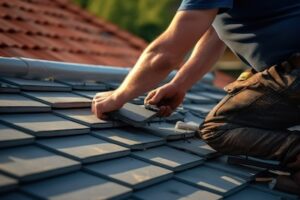The Top Cost Considerations for Roof Restoration
A roof is one of the most critical components of any building, providing protection against the elements and ensuring the structural integrity of the property. Over time, roofs may deteriorate and require restoration to maintain their functionality and aesthetic appeal.
However, embarking on a roof restoration project involves careful cost considerations to ensure a successful and budget-friendly outcome. In this article, we will explore the key factors that influence the cost of roof restoration, offering valuable insights for property owners and guiding them toward informed decision-making.

Common Roof Problems
Before considering restoration, it’s essential to identify the common roof problems that may require attention. These can include damaged or missing shingles, leaks, water ponding, mold growth, and structural issues. Understanding these problems will help you assess the extent of the restoration needed and estimate the associated costs.
Roof Inspection and Assessment
Before diving into a roof restoration project, it is essential to conduct a thorough inspection and assessment of the existing roof condition. Engaging a professional roofing contractor to perform this evaluation is crucial as they can identify any underlying issues such as leaks, damaged shingles, rotting wood, or structural problems. The cost of the inspection will vary depending on the size and complexity of the roof.
Material Selection
Choosing the right materials for roof restoration is vital for durability, longevity, and cost-effectiveness. Several factors influence material selection, including the climate, architectural style, and budget. Common roofing materials such as asphalt shingles, metal, tiles, and slate each have distinct advantages and costs associated with them. While asphalt shingles are the most affordable option, they may not be as durable as metal or slate. Understanding the pros and cons of different materials and their long-term maintenance requirements will help in making an informed decision.
Scope of Restoration
The extent of restoration required is another significant factor that affects the overall cost. If the roof damage is localized, such as a few missing shingles or minor leaks, the restoration expenses will be relatively lower. However, extensive damage or structural issues may require more significant repairs, including replacing damaged sections, reinforcing the underlying structure, or addressing insulation concerns. The complexity and scale of the restoration project will impact both the cost and the time required to complete the work.
Labor and Contractor Costs
Hiring an experienced roofing professional is crucial for ensuring a high-quality restoration and minimizing the risk of future problems. The cost of labor and contractor services can vary significantly based on factors such as location, experience, reputation, and the complexity of the project. It is advisable to obtain multiple quotes from reputable contractors and evaluate their credentials, references, and track records before making a decision. While it may be tempting to opt for the cheapest option, it is important to balance cost with quality to avoid potential issues down the line.
Permits and Legal Requirements
Depending on the location and the nature of the restoration work, obtaining permits from local authorities may be necessary. Permit costs can vary widely, and it is essential to factor them into the overall budget. Additionally, some restoration projects may need to comply with specific building codes or regulations, which may impact the cost. Familiarizing oneself with local regulations and engaging professionals who are well-versed in these requirements can help avoid potential legal complications and unexpected expenses.
Maintenance and Future Costs
After the roof restoration is complete, ongoing maintenance is crucial to prolong its lifespan and prevent further deterioration. Regular inspections, cleaning, and minor repairs should be factored into the long-term cost considerations. Additionally, it is essential to anticipate future costs, such as potential repairs or replacements that may be required down the line. Investing in high-quality materials and workmanship during the restoration process can help minimize these future expenses.
DIY vs. Professional Roof Restoration
While some homeowners may consider a DIY approach to save costs, it’s crucial to weigh the pros and cons. Roof restoration is a complex task that requires specialized skills, experience, and equipment. Hiring a professional roofing contractor ensures the work is done correctly, minimizes the risk of errors or accidents, and can potentially save you money in the long run.
The Importance of Roof Restoration
Roof restoration plays a vital role in maintaining the structural integrity and aesthetic appeal of your property. A well-maintained roof protects your home from the elements, prevents leaks, and enhances energy efficiency. By addressing issues early on through restoration, you can avoid more significant problems and costly repairs down the line.

Frequently Asked Questions
How much does roof restoration cost?
The cost of roof restoration varies depending on various factors such as the size of the roof, materials used, labor costs, and the extent of damage. On average, you can expect to pay between $5,000 and $15,000 for a roof restoration project.
Is roof restoration worth the investment?
Yes, roof restoration is worth the investment. It can extend the lifespan of your roof, improve energy efficiency, prevent leaks, and enhance the overall appearance of your property. Restoring your roof in a timely manner can also help you avoid more significant problems and expensive repairs in the future.
How long does roof restoration take?
The duration of a roof restoration project depends on the complexity of the work, the size of the roof, and the weather conditions. On average, roof restoration projects can take anywhere from a few days to a couple of weeks to complete.
Can I claim insurance for roof restoration?
Whether you can claim insurance for roof restoration depends on your specific insurance policy and the cause of the damage. Review your homeowner’s insurance policy and consult with your insurance provider to determine if you are eligible for coverage.
Can I DIY my roof restoration?
While it’s technically possible to DIY roof restoration, it’s not recommended unless you have the necessary skills, experience, and safety equipment. Roof restoration involves complex tasks that require professional expertise to ensure a high-quality and long-lasting result.
How often should I restore my roof?
The frequency of roof restoration depends on various factors, including the age of your roof, the climate in your area, and the presence of any underlying issues. In general, roof restoration is recommended every 10 to 15 years or as needed based on the condition of your roof.
Conclusion
Roof restoration is a significant investment that requires careful consideration of various cost factors. From conducting a thorough inspection to choosing the right materials and hiring reputable roofing contractors, each decision influences the overall project cost. By taking these considerations into account and planning meticulously, property owners can ensure a successful and cost-effective roof restoration. Remember, a well-maintained and restored roof not only enhances the aesthetic appeal of the property but also provides long-lasting protection, making it a worthwhile investment in the long run.
